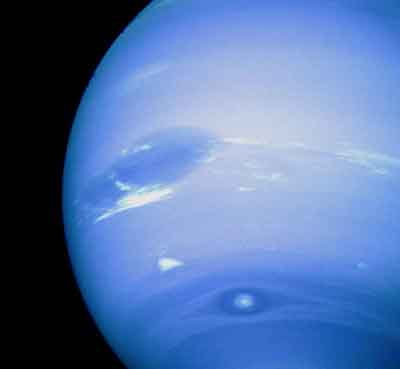|
|
|
|

NEPTUNE NEPTUNE was the last stop that the ground breaking Voyager spacecraft made on its journey through the solar system. The amazing mission had one more surprise for us, though, as it found "geysers" on Triton, one of Neptune's moons.Nearly 4.5 billion kilometers from the Sun, Neptune orbits the Sun once every 165 years, and therefore it has not quite made a full circle around the Sun since it was discovered. It is invisible to the naked eye because of its extreme distance from Earth. Interestingly, due to Pluto's unusual elliptical orbit, Neptune is actually the farthest planet from the Sun for a 20-year period out of every 248 Earth years. |
|
The eighth planet from the Sun, Neptune was the first planet located through mathematical predictions rather than through regular observations of the sky. When Uranus didn't travel exactly as astronomers expected it to, two mathematicians, working independently of each other, proposed the position and mass of another, as yet unknown planet that could account for Uranus' orbit. Although "the establishment" ignored the predictions, a young astronomer decided to look for the predicted planet. Thus, Neptune was discovered in 1846. Seventeen days later, its largest moon, Triton, was also discovered. Neptune is the eighth, or next to last, planet in our solar system. It is located in between Uranus and Pluto, and is a very long way away from the Sun. Its average distance from the Sun is almost 2.8 billion (2,800,000,000) miles, or over thirty times the distance from Earth to the Sun. The orbit, or path, Neptune follows around the Sun is almost a perfect circle. The closest Neptune gets to the Sun is about 2.7 billion miles, and the furthest away it gets is a little over 2.8 billion miles. At this distance, our Sun is just another bright light in Neptune's sky. Since Neptune is so far away from the Sun, one of its years, which is the amount of time it takes for the planet to go around, or orbit, the Sun once is a very long time. A year on Neptune lasts for 165 of our Earth years! A day on Neptune, though, is shorter than a day here on Earth. The gas planet spins, or rotates, once every sixteen hours. Can I See It?
How Big Is
It?
Does It Have
Rings?
How Many Moons
Does It Have?
How Did It
Get Its Name?
What Is It
Made Of?
What's It Like
On The Surface?
|
|
|
|
|
|
|
|
|
|
|
|

Welcome to Rajesh Chopra's Guest Book and comments Please |

|
All rights reserved. No part of this publication and other sites of under liveindia.com may be transmitted or reproduced in any form or by any means without prior permission from the publisher Live India Internet Services or Rajesh Chopra, L.C.Premium Cables, 1826, Amar Nath 2nd Building, Bhagirath Palace Delhi - 110006, India. Liveindia.com or Mr.Rajesh Chopra is not responsible for any wrong information under this site, For confirmation of any information it is recommended that you can reconfirm from yours end |
 |